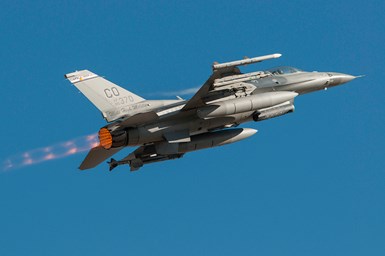GE Additive, WSU-NAIR Partner to Accelerate Military’s Metal Additive Tech Implementation
The partnership will accelerate metal additive adoption within the military aerospace and defense industrial base by advocating for common practices, rapid qualification and certification, and the development of a shared database for additive manufacturing data and knowledge.
Share
Read Next

U.S. F-16 with F110 engine. Photo Credit: GE Aviation
GE Additive and Wichita State University’s National Institute for Aviation Research (WSU-NIAR) have signed a nonbinding Memorandum of Understanding for a new collaborative effort aimed at supporting the U.S. Department of Defense’s (DoD) accelerated adoption of metal additive manufacturing (AM) technology.
According to the partners, AM technology within the commercial and military aerospace and defense sector has grown significantly over the past decade and, in that time, GE and WSU-NIAR have worked closely with the DoD, FAA and other stakeholders to accelerate safe adoption of AM for high criticality applications. NIAR is known for developing digital twins of various aging vehicles, while GE Additive utilized metal additive technology to print out-of-production and obsolete spare parts from digital twin data.
“GE has been doing this for a long time and they have cracked the additive manufacturing code,” says John Tomblin, WSU senior vice president for Industry and Defense Programs, and NIAR executive director. “You can see it in their data and process control.”
GE Additive is familiar with WSU-NIAR’s material qualification capabilities and how it complements the company’s work. “We realized the benefits of putting our relationship with NIAR on a more formal footing,” says David Handler, general manager – government business at GE Additive. “We visited the team at Wichita to see their facilities firsthand and that accelerated our discussions to determine how we can bring our complementary abilities to bare for the warfighter.”
The partnership is designed to accelerate metal additive adoption within the military aerospace and defense industrial base by advocating for common practices, rapid qualification and certification, and the development of a shared database for AM data and knowledge.
“The real beauty about this partnership is bringing the knowledge of the two sides together to advance AM technology to benefit the DoD,” Tomblin says. “The time is now.”
According to Handler, NIAR’s material database capabilities are an important asset needed to build a comprehensive, secure, accessible and standard format for materials data that all depots can use. GE Additive and NIAR aim to establish an industry platform that is flexible enough to be used across all branches of the DoD.
Related Content
-
ConocoPhillips Sees Oil and Gas Supply Chain Opportunity With Additive Manufacturing
Production of parts when needed and where needed can respond to the oil and gas sector’s multibillion-dollar challenge of holding parts in inventory. The supply chain benefit will justify additive even before the design freedoms are explored.
-
Seurat: Speed Is How AM Competes Against Machining, Casting, Forging
“We don’t ask for DFAM first,” says CEO. A new Boston-area additive manufacturing factory will deliver high-volume metal part production at unit costs beating conventional processes.
-
What Does Additive Manufacturing Readiness Look Like?
The promise of distributed manufacturing is alluring, but to get there AM first needs to master scale production. GKN Additive’s Michigan facility illustrates what the journey might look like.













